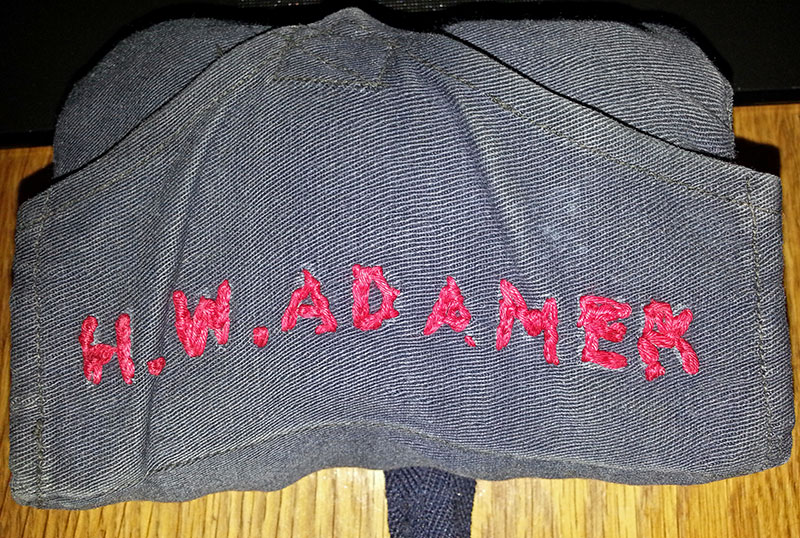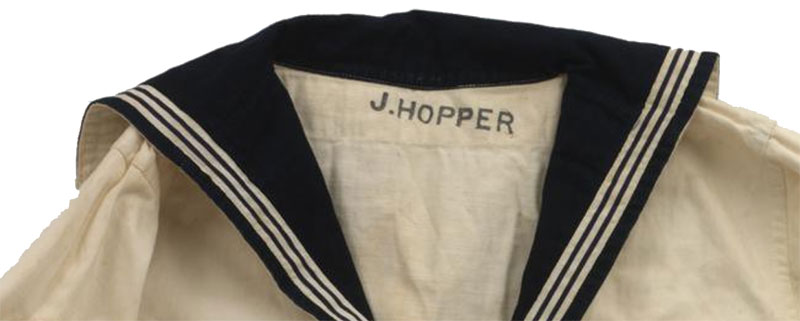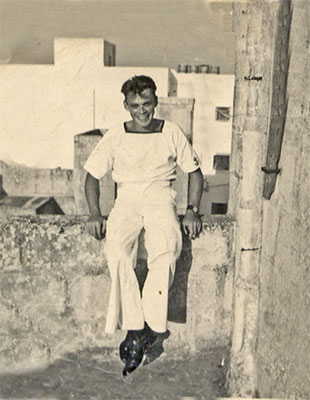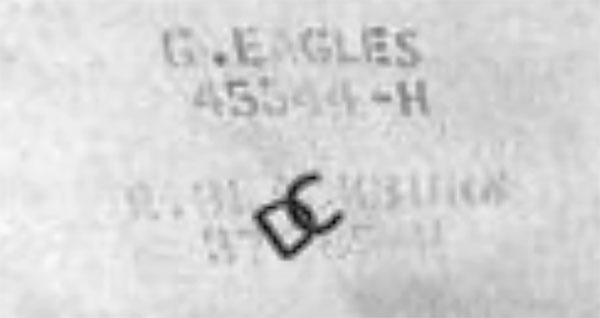Introduction
In June 2020, I received an email from Dawn Fallon that contains images of her father's Leslie Edward Smith's namestamp or more properly name type, or in Royal Navy parlance Type, Name.
Leslie Smith's Name Type block. It looks like someone made a false start on one side of Leslie's



These name types were issued to every Royal Navy sailor from at least the start of WWI until 1985. Maybe at least until 2007 in training ships like HMS Raleigh. Name types must have been so common and mostly forgettable that I couldn't find a single web page about them, just bits and pieces scattered across the internet, and so this page was started.
It could be that name types were even older than WWI. There is an article in "The White Ensign: Royal New Zealand Navy Museum Journal" of Autumn, 2008 called "Every Sailor needs a House wife!" says that "It is not known when housewives were first formally issued in the RN, but a poster, dated 1898, shows a housewife alongside other items necessary for the maintenance of one’s uniform such as brushes, blackening for boots, soap, a soap bag and a scrubbing brush." and that "Originally they contained needles, cotton thread, safety pins, a thimble, buttons, scissors, wool (for repairing woollen clothing and darning socks), a name type stamp and red silk for embroidering ones name or initials into uniform items."
Name types were issued so that a sailor's clothing could be marked with their name. Living in close proximity all the time meant that now and then pieces of clothing would go missing, especially just before a kit inspection. As missing clothing had to be paid for it was important for sailors to mark their clothing as their own.
The letters were 3/8" high and white clothing was marked in black ink or paint while black/navy blue clothing was stamped using white paint. Woollen items were first stamped and then the paint or ink covered in red worsted embroidery.

Red worsted embroidery on housewife
Photo: Photo kindly submitted by Wal Adamek
Wal served in the Royal Navy from 1966 to 1990
There were larger blocks made for items such as ditty boxes, kit bags and hammocks, but those were not a personal issue item.
Items had to be marked in a specific place, usually centered above the collar or waistband as appropriate. Handkerchiefs and scarves had to stamped diagonally across the middle. During kit inspections or musters, the clothing had to be folded so these markings showed.
Bernard Hallas became a Royal Marine in 1935 and in his My Life My War says that his name type had his name on one edge and his service number on the other.
Almost all the name types I've seen were made from a single block of wood, but there was another type around and those were made with each letter made on their own block which were then affixed together to make a name.

Name type for T. Cassidy
Image: Great War Forum: Royal Navy Timber Name Stamp

Name type for T. W. Gregory
Image: Imperial War Museums EQU 3624

Royal Navy jumper stamped with J. Hopper
Image: Imperial War Museums UNI 7478
In January 2021, Michael Headon emailed me about his father, Frank Graham Headon, and his time in the Royal Navy. Frank was born on August 2, 1935 in Devon and joined the RN on October 3, 1950. He retired from the navy on June 26, 1960. He spent his time on various ships, including HMS Gambia from March 12, 1953 to June 20, 1954.

Frank Graham Headon. Photo very kindly supplied by his son, Michael Headon
Frank wrote a memoir and Michael very kindly sent it to me. Frank did his initial training at HMS St. Vincent, the Gosport shore establishment from October 3, 1950 to 19th October 19, 1951. He wrote of this time:
4.30 on a pleasant Sunday afternoon, 3rd October 1950! Over time I may have forgotten many dates, but this was certainly not going to be one of them. First meal in His Majesty’s Royal Navy. There it was in all its glory waiting for us, a large white dinner plate, one thick slice of bread cut mechanically from an old type sandwich loaf topped with a small cube of rock-hard margarine. Alongside the plate was a large white china mug, half full of lukewarm tea. Nothing homely or inviting about this place.
We were going to spend four weeks in this area being kitted up, fitted out and indoctrinated into the Navy. I do not remember being told, but found out a lot later, that during those first four weeks we could have walked out, I don’t think anyone did. We were probably too scared to go against the flow.
We were taught how to march, salute, and sew, yes sew. When we had received all our kit, we were instructed how to mark it, in the main we had to sew our names in chain stitch with red Sylko. Our new wardrobe was also stamped in black ink, with our names. The letters were about half an inch tall. We were given a certain amount of time over the four weeks to finish the job. This was fine for someone called John Dee, ‘J. Dee’, but there were a range of names, the worst I think was ‘Michael William Albert Higginbottom’ or something similar, ‘M.W.A. Higginbottom’. He had a few late nights.
Also, we had to be taught to fold and iron every piece in a certain way. Believe it or not there was a very good reason for this, whenever you moved ship your belongings had to be packed into your kitbag, again in a very special manner so that when you next came to use it, all the creases would be in the right place.
Kit lockers had to be set out in exactly the same manner, bedding had to be folded and laid out in the regulation style. Only ‘Perfect’ was acceptable.
There were rules for everything, break them at your peril. The dormitories were like a shrine, always everything in its place. We were now just a number, not a face to be recognised, not a person, just a tiny cog in a huge wheel. For these first four weeks we were put through the grinder.
In 1916, sailor, author, and journalist, H. Taprell Dorling, wrote the fictionalised account of a sailor's life, "Pincher Martin, O.D.: A Story of the Inner Life of the Royal Navy". The book is often cited as the source of much of William Golding's 1956 book "Pincher Martin." In Dorling's book there is an account of people swapping clothes for the purpose of kit inspections.
Now, Mr Midshipman Taut, R.N., was used to the wiles and deceptions of those men who would sooner do anything than purchase new clothes. He had known individuals who borrowed garments from their friends to make up for the deficiencies in their own kits when these were being inspected. Sometimes, to heighten the deception, they even went to the trouble of marking the loaned clothes with their own names. The regulations on the subject lay it down that blue articles shall be marked with white paint and white garments in black, each man being provided with a wooden type inscribed with his name for this purpose. But the gay deceivers had discovered that white chalk and ordinary boot-blacking were very efficient substitutes for the paint, for the temporary markings so caused could easily be brushed out before the garments were returned to their rightful owners after kit inspection. Moreover, unless the mustering officer was particularly inquisitive or suspicious, the chances were fully fifty-four to one that the deception would never be noticed.
I'm not sure that the above would actually work, but that's what is in the book.
Declared Clothing
When kit was officially exchanged it had to be overstamped with a DC or Declared Clothing stamp and the new owner's name stamp was placed under or above it. These stamps were only held by a designated officer.

A DC mark on clothing
Image: Royal Canadian Navy Seaman's Book, BRCN 3029, January 1960
Sources
Unfortunately many web pages do not last a year before they are moved or deleted and many entire websites barely make it to 3 three years before they are gone. If the links on these pages do not work, try searching for them in the Internet Archive.
British & Commonwealth Military Badge Forum
Great War Forum: Royal Navy Timber Name Stamp
Imperial War Museums - a great resource for naval historians
My Life My War by Bernard Hallas
Navy Net: Marking your kit pre Raleigh? - This is the site that mentions name types might still be used as late as 2007
Pincher Martin, O.D.: A Story of the Inner Life of the Royal Navy by H. Taprell Dorling, W & R Chambers, 1916
Royal Canadian Navy Seaman's Book - BRCN 3029, January 1960
Royal Navy Uniforms 1930-1945 by Martin J. Brayley, Crowood Press, 2015
Tales from the Supply Depot: Royal Navy Rating’s Uniform - Some nice examples of stamped clothing
The White Ensign: Royal New Zealand Navy Museum Journal: Every Sailor Needs a House Wife! - Autumn, 2008
This page created July 11, 2020; last modified February 27, 2021








